At the beginning of May this year, December oat futures at the Chicago Board of Trade were trading at $1.503Ú4 (U.S.); a year ago at $1.271Ú2.
On Oct. 23, December oats closed at $1.941Ú2 per bushel in Chicago, after trading above $2 a bushel earlier in the week, and at $191.50 per tonne in Winnipeg.
The market this year is a prime example of what happens when demand for a commodity is steady – or increases slightly – but supplies are driven down.
The Canadian oat crop is pegged by Statistics Canada in its latest crop report at 2.83 million tonnes, compared to 3.64 million tonnes in 1994. That’s about 100,000 tonnes below the five-year average crop, said Al Dooley, grains and oilseeds analyst with Alberta Agriculture.
Read Also

StatCan stands by its model-based crop forecast
Statistics Canada’s model-based production estimates are under scrutiny, but agency says it is confident in the results.
While Canada’s oat crop is down this year, it hasn’t dropped as severely as the U.S. oat crop.
The United States department of agriculture estimates the 1995 crop will be just 2.5 million tonnes, down a million tonnes from 1994.
But the small crop hasn’t dulled America’s appetite for oats. USDA estimates imports this year will be 1.6 million tonnes.
Nolita Clyde, coarse grains analyst with Agriculture Canada’s grains policy directorate in Winnipeg, said they estimate 1.5 million tonnes of those exports will come from Canada.
Lack of competition from Finland and Sweden also helped Canada become the dominant oat supplier to the U.S.
Rob Dzisiak, analyst with Linnco Futures Group in Winnipeg, said both those countries have reduced exports to the U.S. since they joined the EU this year. Some of their production has found markets on the continent, he said, but another factor is joining the EU meant scaling back export subsidies.
For Alberta Wheat Pool oat selector Ken Wulff in St. Albert, Alta., it means he’s been paying a milling premium of between $5-$7 per tonne over the street price for 2 CW feed oats – between $2.10-$2.20 per bushel.
Wulff doesn’t see that price changing much through the year, and in fact thinks supplies could get tighter by next summer.
Dzisiak said oats have historically traded at about 60 percent of the value of corn. With tight supplies throughout the coarse grains complex, he expects the relationship to hold.
If corn breaks through the $4 (U.S.) per bushel barrier that some are forecasting, then Dzisiak said it’s possible for oats to hit $2.40.
















